Allen Tiller's Blog, page 7
December 4, 2023
Alex Creyghton - Gawler Town Crier
Alex Creyghton - Gawler Town Crier
First published on the ‘Gawler: Colonial Athens’ blog on 16/02/2021
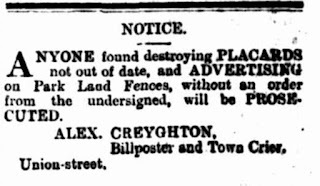
Alex Creyghton was employed by the Gawler South Council (previously District of Munno Para West Council), which covered the south side of the South Para River.
Creyghton was a painter who worked from Union Street but also worked as a lamplighter, billposter (signage) and town crier.
He was a town crier in Gawler South from as early as 1888 up until he died in 1905. He worked as Gawler’s principal Lamplighter from 1866 until 1897.
Creyghton was employed in Gawler to light and extinguish the gas lamps around the town. He rode a bicycle with a ladder on his shoulder. Gawler Council refused to light the gas lamps for 6 nights before, and six nights after a full moon. It also demanded all lamps to be extinguished from 10:30 p.m. to save money.
From 1866 until 1897 Gawler’s lamplighter was Mr Creyghton. Creyghton was replaced in 1897 after a lamp exploded, and he could not explain to the council how it occurred.
The Bunyip published a short epitaph regarding Creyghton on 13 January 1905,
DEATH of Mr. Alex Creyghton
On Tuesday last Mr. Alex Creyghton, Gawler's well-known billposter and town crier, expired at his residence, Gawler South. The deceased arrived from Somerset in the Forfifeshire in I876 and settled at Gawler, where he followed the avocation of painter and signwriter until about eighteen years ago, when he entered into the bill-posting business. He attained the ripe age of 72 years.
Researched and written by Allen Tiller © 2021
Picture: Alex Creyghton 1888 Advertising Bunyip 12 October p. 3.
[1] 'Advertising', Bunyip. (19 October 1888), p. 3.
[2] 'EDITOR'S NOTES.', Bunyip, (13 January 1905), p. 2.
December 2, 2023
Old Bill Taylor – Gawler Town Crier
Old Bill Taylor – Gawler Town Crier
First shared on ‘Gawler: Colonial Athens’ blog, 9/2/2021
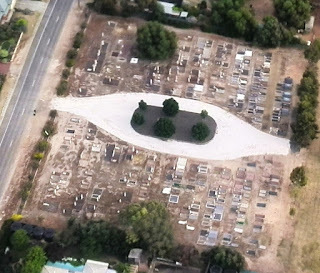 St George's Anglican Cemetery
St George's Anglican CemeteryPhoto: Gawler History Team
William Taylor was born in Buckinghamshire England in May 1818. He married Mary Hillsdon (1817-1879) in 1839.
Their children Ann, Sarah and John were born in England, and Hannah and the children following were born in South Australia. Their children were:
Ann Taylor (1840–1840), Sarah Taylor (1842–1921), John Taylor (1844–?), Hannah Taylor (1847–1849), Elizabeth Taylor (1849–1866), Lucy Taylor (1850–1924), Thomas Henry Taylor (1851–1911), Lydia Mary Taylor (1854–1917), William Richard Taylor (1857–1933), James Taylor (1859–1864).
William Taylor was known around Gawler as ‘Old Bill’. He was a local Town Crier.
A 1925 The News article reported the following on Gawler Town Crier ‘Old Bill’ Taylor,
In its early days Gawler possessed a town crier, who combined poetry with oratory. For the poetry he made an extra charge. When announcing a sale at a building where its solitary room was used for religious services, and the collars as a store for wines, the crier was frequently heard to recite the foIlowing lines, much to the amusement of the public:
"There's a spirit above and a spirit below,
A spirit of weal and a spirit of woe,
The spirit above is the Spirit Divine,
The spirit below is the spirit of wine."
The verse above is a quotation from Anna L Wards Dictionary of Quotations written by “MS”. It was written about 1825 about the vaults below Portman Chapel, Baker Street, London.
Old Bill Taylor commentated on the 1869 election vote between Samuel Bradley and David Thompson. As printed in the Bunyip at the time (and later reprinted in 1932):
Gawler In Other Days
Only 28 ratepayers voted on Wednesday last in the contested Ward (South)
No one seemed to take the least activity hunting up voters for the involuntary candidates, and nothing tended to show that any election was going on with the exception of the town crier, Mr. William Taylor who perambulated the Ward read the following notice, which he has left with us for publication, that his name may be emblazoned on the herald of fame as one of local laureates:
To all the electors of South Ward.
Haste to the pool and quick record
Your votes for Dave or Sam;
If Dave is elected, you will place
The saddle on. him who won the race;
But if for Sam you vote.
You'll send in one who soon will prove
That public interests him move,
He'll never turn his coat.
You that have not voted in this Ward,
I hope you'll come in time;
I think you will not judge me hard.
For it will enhance the rhyme,
You know that for the contest
There's two, that's Dave and Sam.-,
Now all take your opinions
And vote for the best man,
Because there is no botheration
In being one of the Corporation.
The result showed— Samuel Bradley, 20; David Thompson, 8. Dec. 4, 1869.
In 1871 Mr John Knowles proposed that Town Crier, William Taylor run for Council.
Old Bill Taylor died on 4 February 1876 while walking from the Gawler Railway Station towards Murray Street.
SUNSTROKE: Mr. W. Taylor, our bill sticker and town-crier, received a sunstroke today about noon while in the occupation of his duty. He was travelling between the Railway Station and Gawler, and was observed to fall down. Dr. Popham was in immediate attendance and did everything possible for his recovery. He died about 3 o'clock, to-day, just as we Were going to press.
William Taylor is buried at St George’s Cemetery, Cheek Avenue, Gawler East.
Researched and written by Allen Tiller © 2021[1] 'GAWLER COUNCIL', News, (25 November 1925), p. 6.
[2] 'CORRESPONDENCE.', The Register, (29 October 1910), p. 4.
[3] 'GAWLER IN OTHER DAYS.', Bunyip, (20 May 1932), p. 10.
[4] 'MUNICIPAL ELECTIONS.', Bunyip, (25 November 1871), p. 3.
[5] 'BAROSSA MINING NEWS.', Bunyip, (4 February 1876), p. 2.
December 1, 2023
Thomas ‘Tommy’ Kendall – Gawler Town Crier
Thomas ‘Tommy’ Kendall – Gawler Town CrierFirst published on the 'Gawler: Colonial Athens' blog on 2/2/2021
Thomas ‘Tommy’ Kendall was one of Gawler’s early Town Criers. He came to South Australia on board the barque Kingston on 18 December 1848, arriving at Port Adelaide from Sydney. He travelled with his wife Catherine.
Thomas had previously been a Private in the 80th Regiment of Foot, based at Chatham Kent.
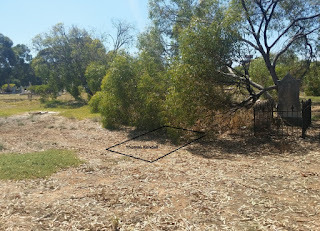 Thomas Kendall's grave, West Tce. Cemetery
Thomas Kendall's grave, West Tce. CemeterySource: Dwight Baker - Find a Grave 2016
The Bunyip wrote the following about a Town Crier named Kendall in 1879 under an article titled ‘Sayings and Doings Colonial Athens’:
BILL STICKING AND TOWN CRYING.
So we are to have a new bill poster and town cryer in Gawler. That's a sign of progress I think, and he's sure to get large patronage.
His name is Kendall, and I wouldn't wonder if he don't 'kindle' some enthusiasm in the hearts of the people here. Why do town cryers always use bells? This is an age of novelty, and I would suggest a drum as a better style of announcing sales and entertainments. The beating of a drum would stir all hearts with the enlivening sound; even yet I fondly remember how in childhood I often listened to the drummer, as he twirled his stick with rub a dub, 'dow-de-dow,'
Therefore my advice to, the new cryer is to introduce the drum, and beat up a hearty 'row-dow-dow' whenever a sale is on.
Thomas suffered an elbow injury while working as an ostler at the Mill Inn in 1881.
Accident.—A serious accident happened on Tuesday morning at the Mill Inn, Gawler, to Mr. Thomas Kendall. It appears that Kendall although warned against doing so, went into the stable and began to clean a horse belonging to Mr. Denton, of Morgan, when the horse, which is generally quiet, kicked Kendall in the right elbow, putting it out of joint Mr. Popham was immediately in attendance, and set the fractured limb.
Thomas died at the Adelaide Destitute Asylum on 25 July 1883. He was 73 years old.
Upon his death, The Bunyip newspaper published the following epitaph regarding Tommy’s death, buried deep within another article:
On Monday a Gawler celebrity took his departure for that bourne from whence no man returneth. Thomas Kendall, or "Tommy," as he was more generally known by, died in the Adelaide Hospital from general decay. For some years past he has been the favorite town crier and bill sticker, and well has he done his work. He lived in poor circumstances, and although there were many who would have helped him, his independent spirit kept him from taking their aid, as he preferred to be free of obligation to any one.
Also printed in the Bunyip was this epitaph in 1883. The excerpt from an article is written in the exact language used below, mocking the poor and uneducated. Perhaps this was an attempt at humour.?
Mrs. Harris On Things In General, Gawler Things in Particular
A few days ago, poor old Tommy Kendall took his larst journey for a distant shore, where I trust neither bill-sticking nor crying will be required of him.
The old gentleman was not a bad sort, full of informashun bought and paid for, possessing many good traits of character ,and your Betsey espeshily kan testify to his honesty, independent spirit, and an earnest desire to act squarely. I think those are very good traits in a man an nis poverty ort not to be a barrier for honorable menshun. May he have better times of it than he have had lately are the earnest wish of
Yours trooly,
Betsy Harris.
Researched and written by Allen Tiller © 2021.
Photo: Dwight Baker (contributor 47306645), Find a Grave, database and images memorial page for Thomas Kendall (unknown–26 Jul 1883), Find a Grave Memorial no. 159724849, citing West Terrace Cemetery, Adelaide, Adelaide City, South Australia, Australia ; [1] 'SHIPPING INTELLIGENCE.', South Australian, (22 December 1848), p. 2.
[2] 'SAYINGS AND DOINGS COLONIAL ATHENS.', Bunyip (21 February 1879), p. 4.
[3] 'GENERAL NEWS.', Adelaide Observer, (8 October 1881), p. 31.
[4] Thomas Kendall, Australia, Death Index, 1787-1985, vol. 129, p, 407
[5] 'TAXATION.', Bunyip, (3 August 1883), p. 2.
[6] 'MRS. HARRIS ON THINGS IN GENERAL, GAWLER THINGS IN PARTICULAR.', Bunyip, (10 August 1883), p. 3
November 30, 2023
Gawler Town Crier’s
Gawler Town Crier’sFirst published on the 'Gawler: Colonial Athens' blog on 26/01/2021

The Town Crier’s job was to make public announcements in the streets. Traditionally they dressed very elaborately to distinguish themselves as someone of importance separate from the public. The Town Crier would ring a large bell and shout the words “Oyez, Oyez, Oyez!” before making their announcement. ‘Oyez’ is late Middle English for ‘Hear ye’ and means ‘silence and attention’.[1]
(Some of) Gawler’s Town Criers
Old Bill Taylor. (William Taylor)[1]
Thomas ‘Tommy’ Kendall.[2]
Mr E. Luxton.[3]
Alex Creyghton [4]
Rowley (ex-police officer Crier for the courts).[5]
Over the coming weeks, research about these Town Crier’s will be revealed.
A photo of the Gawler Town Criers bell can be found Gawler Cultural Heritage Centre’s eHive - Click here:
Researched and written by Allen Tiller © 2021
Advertisement: 'DROPS OF INK.', Bunyip, (3 March 1876), p. 3.
[1] Oyez, Merriam-Webster, Incorporated, (2021), https://www.merriam-webster.com/dictionary/oyez.
[2] 'Out among the People', The Advertiser, (15 October 1937), p. 31.
[3] 'SAYINGS AND DOINGS COLONIAL ATHENS.', Bunyip (21 February 1879), p. 4.
[4] 'Local and General Topics.', Bunyip, (22 August 1913), p. 2.
[5] 'LOCAL AND GENERAL.', Bunyip, (14 January 1921), p. 2.
November 28, 2023
Map Kernow: Map the Miner
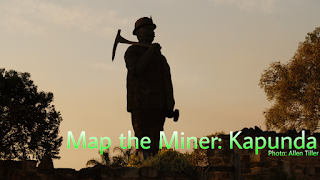
If you've ever visited Kapunda, you would remember passing the giant Cornishminer Statue at the southern end of town. Known as The Big Miner to some, and as Map Kernow, or Map the Miner to others. Themonument was constructed in 1988 and officially opened on June 5th, 1988. Themonument was designed and built by Ben Van Zetten after being suggested bylocal John Davidson that a memorial be erected to commemorate the influence theCornish Miners had on the town.
The Rotary Club of Kapunda organised a funding campaign and successfully raisedthe money needed. Over the year’s other local volunteer community groups andthe local council have helped to assist in beautifying the grounds around theStatue making it a focal point for tourists entering Kapunda.
The plaque on the miner reads;
"This statue is a monument to the profound, role and contribution of theCornish miner in the Kapunda and in due course in other mines in SouthAustralia. The Kapunda mine, established in 1844, was the first successfulmetal mine in Australia and contributed greatly to the economic development ofSouth Australia. Up to its closure in 1878 ore to the value of more than £1million was produced and up to 340 men and boys, mainly from Cornwall wereemployed."
In June 2006, Aaron Ashton was arrested after setting a fire as a “prank” atthe base of the statue. Ashton claimed in court proceedings that he did notthink the statue would be made from flammable materials and that he did notintend to destroy the statue.
He pleaded ‘Not Guilty’ to the damage caused, estimated to be around$95,000, but was found guilty by Judge Muecke in 2007, and sentenced to severalyears in gaol for his crime.
Researched and written by Allen Tiller © 2017
Bibliography
Fewster S, 2008, Teen vandal's idiocy destroyed touristicon Map the Miner, The Advertiser, viewed 24 March 2017,http://www.adelaidenow.com.au/news/so...
Monument Australia. 2010. Map the Miner | MonumentAustralia. Monument Australia, viewed 1 March 2013, http://monumentaustralia.org.au/themes/technology/industry/display/50956-map-the-miner.
November 21, 2023
Gawler before, and its First Building.
Documentary evidence reveals that Gawler came under the foot of the white man in 1837 when a survey party to the Barossa hills found a wanderer in the scrub. Being ill, they put him on the bullock dray. Reaching the ford over the South Para River, they found him dead, and so they buried him in a hollow tree, decently covering the body with bark and sticks. They called the ford Dead Man's Pass, and the place to this day retains the name.
Gawler’s first building was the Old Spot Inn, built by Mr. Schiebner. By the end of 1839 the traffic from the River Murray and the North was so great that Mr. King had to give up entertaining, so he induced Mr. Schiebner to build and provided the money for the building. Soon after that time, there was a small dairy station up the South Para River, belonging to Captain Walker, and Messrs Grant and Butler (grandfather of the State's ex-Premier) had a sheep station at Yattalunga.
'Gawler before, and its First Building.', Bunyip, (3 February 1939), p. 9., http://nla.gov.au/nla.news-article967...
The Kapunda Royal Visit: 1866
The Kapunda Royal Visit: 1866
Originally posted on ' The History of Kapunda' on Monday, March 20, 2017
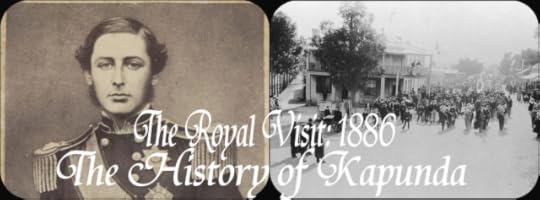
In 1886, Kapunda was graced with a Royal visit from the then Duke of Edinburgh, Prince Alfred,
Queen Victoria's second son. While visiting South Australia on a royal tour, Prince Alfred made a visit to Kapunda on November 6th, travelling to Kapunda via train direct from Adelaide Station.
Once the Prince arrived at Kapunda Train Station, which had been adorned with pine branches and fronds (as had much of the town, simple decorations for simpler times), The Prince was whisked into an awaiting carriage. The ornamental carriage made its way towards the centre of town, surrounded by soldiers, and a large crowd of cheering and adoring Royal fans, keen to get a glimpse of the Prince.
Throughout the town, large Union Jack flags waved next to large banners with the words "Welcome to our Sailor Prince” written across them. Around the town were flags and signs of family crests and the flag of St George. Prince Alfred was taken via carriage to Mr Crase's newly refurbished North Kapunda Hotel. After a tour of the hotel from top to bottom, the Prince retired briefly to a sitting room upstairs that had been carefully prepared for his arrival.
A banquet held in his honour commenced in the rear ballroom (now demolished) of the hotel. Amongst the many dishes served was one dish usually reserved for the dining room of the Queen, and only served within the walls of the Palace. The Prince was very curious about this and asked for the cook to be brought to him for questioning.
The Prince questioned the cook on his preparation of the meal, asking how he knew the recipe. The cook informed the Prince, that he had been the Queen's personal chef prior to arriving in Australia, and now cooked and served in The North Kapunda Hotel. Upon hearing of the Royal Tour, he had become excited, and prepared the specialty Royal meal in the Prince's honour, to make him feel a little more like he was at home.
After a number of hearty speeches by town dignitaries, the Prince, and Mr Crase, three cheers of “Hoorruh” were given. Prince Alfred made his way back to the Kapunda Railway Station, where he boarded the Royal Train and made his way back to Adelaide continuing his tour of the country.
Researched and written by Allen Tiller © 2017
November 14, 2023
That Kapunda Crown
That Kapunda Crown
Originally posted on the 'History of Kapunda' blog on Friday, August 17, 2012
While conducting research for an investigation for another of our passions, Eidolon Paranormal; Karen and I stumbled across this piece of Kapunda's forgotten history. We printed the story and placed it on the notice board in the front bar of the Clare Castle Hotel, hoping someone would come forward with some information. Unfortunately, not even the longtime regular's had seen the image before!
We had another mystery to be solved in Kapunda!
Below is what we posted on the notice board in the Hotel:
"Kapunda Revelation"
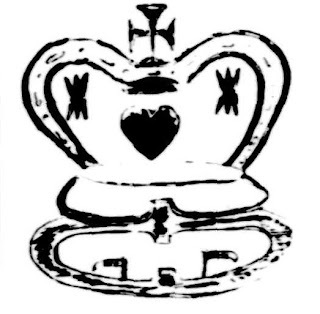
"After many layers of paper in the quaint Clare Castle Hotel at the Adelaide end of Kapunda had been removed, this design, measuring three feet, was found painted on the wall above the mantelpiece in the front room: it is in gold, green and black."
Later, we were researching for another Kapunda location and stumbled across the answer to the mystery of the Kapunda crown. The mystery of The Kapunda Crown was solved by this article, written in The Advertiser in 1954.
That Kapunda Crown
With commendable promptitude, Mrs E. O'Neill, president ofGlenelg Sunshine Club has explained from 'Carmel,' 3 College street, Glenelg.the origin of the Crown at the Clare Castle Hotel. Kapunda
'The picture in your column took my mind back to mychildhood watching my father, the late Edward (Ned) Murphy drawing that crown.He was the licensee.
'I do not remember why, as I was only six. Father had apeculiar trait to paint and draw things like this. 'He was a very intelligentman; when he died 21 years ago. at 86. he had retained his remarkablementality.
Did Other Drawings
First, he was the licensee of the North Kapunda hotel forthree years, during which time he was a councillor. Sir Sidney Kidman and MrCharlie Coles were personal friends of his. When Queen Victoria died my parentsdraped the front of the Clare Castle in black. Father drew and painted alife-size picture of Queen Victoria for the centre. About this time, 1901. hedrew the crown. I remember his doing the heart and saying to us children. 'TheThrone and the Queen are the heart of the Empire. Many other hotels bear somedrawing or inscription done by dad at Robe, on the window of a temperance hotelis something he did with a diamond ring.
I, unfortunately, burnt the only photo of the Clare Castleafter father's death. I enclose one of the North Kapunda, taken about 1898. Myfather is the young man in shirt sleeves. Mother is standing by myself, alittle tot looking through the balcony bars. One of the maids holds my babybrother, later an original Anzac.
Kept City Hotels
Mrs O'Neill says her father (Edward Murphy) and mother hadmany guests at their Adelaide hotels. Most famous was Madame Sarah Bernhardt atthe Metropolitan in Grote Street. Mr C. C. Kingston, who lived farther west onthe West terrace corner, wanted her father to buy half of Kingston Park,Marino, for £10. My grandparents were among the first Port Adelaidehotelkeepers. Migrants stayed there until they got work or land,' she adds.
Researched and written by Allen and Karen Tiller © 2012
November 7, 2023
Glenelg Riots - part three - Guy Fawkes Day
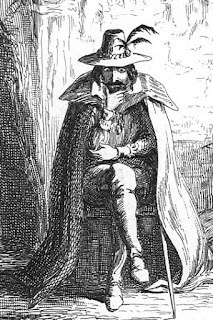
Remember, remember, the 5th of November,
Gunpowder, treason and plot.
I see no reason
Why gunpowder treason
Should ever be forgot.
Guy Fawkes, Guy Fawkes, 'twas his intent
To blow up the King and the Parliament
Three score barrels of powder below
Poor old England to overthrow
By God's providence he was catch'd
With a dark lantern and burning match
Holler boys, holler boys, let the bells ring
Holler boys, holler boys
God save the King!
Way back on January 24th, 2023, I published the first part of this series ‘The Glenelg Riot.’ I decided it would be more fitting to publish this post on the 5th of November - Guy Fawkes Day.
Guy Fawkes Day (also known as Cracker Night, Bonfire Night, and Fireworks night) was an annual celebration in Great Britain and in some Commonwealth countries such as Australia. The day memorialised the attempted assassination of King James 1, a protestant King, by Catholic conspirators.
On November 5th, 1605, Guy Fawkes was arrested while guarding explosives that had been placed under the House of Lords. He was part of a plot to blow up Parliament led by Robert Catesby. The other conspirators were captured and executed on 31 January 1606, but not before Edward Montagu, a Member of Parliament proposed that the King had been saved by Divine Intervention, and therefore the day should be celebrated as a day of thanksgiving.
The 5th of November became a day for the burning of effigies of Guy Fawkes. In its early incarnations, the day celebrated the Protestant King by defiling Catholic Church symbols, such as the pope, by burning effigies. The holiday remained in Australia until circa 1982 when the Government banned all sales of fireworks.
In 1910 Glenelg celebrated Guy Fawkes night with a riot! Crowds had gathered at Mosely Square and Jetty Road to celebrate the evening. All was going well, until around 10pm that evening, an apparent signal went up and firecrackers from every direction were thrown at police.
At around 11pm a large stone was thrown from a lane adjoining Jetty Lane at Constable Harrold. The stone missed him but hit Mounted Constable Clark inflicting a deep wound into his skull which later had to be stitched.A plain-clothed officer arrested the rock thrower, assisted by Constable Keene, who was promptly despatched by a bottle thrown at his head, knocking him out.
The police retreated to the station, but the crowd followed. After a short time, the police came outside and confronted the crowd with their batons drawn. The crowd soon dispersed, and the riot ended.
Researched and written by Allen Tiller © 2023
[1] 'CRACKERS AND CONSTABLES.', Evening Journal, (7 November 1910), p. 4.
[2] 'SOUTH AUSTRALIA.', The North Western Advocate and the Emu Bay Times (8 November 1910), p. 3.
[3] 'RIOT AT GLENELG.', The Sydney Morning Herald, (7 November 1910), p. 9
[4] 'RIOT AT GLENELG.', The West Australian, (7 November 1910), p. 8
November 6, 2023
Barossa Elephant Walk
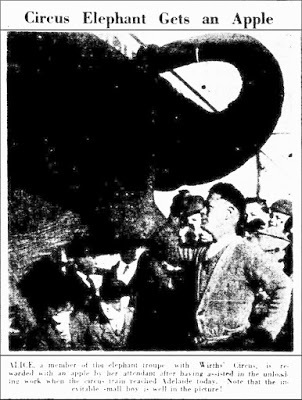 1933, world travelling Wirth Brothers Circus had just finished shows in Adelaide and Gawler, and on July 7th scheduled shows for Angaston in the Barossa Valley.
1933, world travelling Wirth Brothers Circus had just finished shows in Adelaide and Gawler, and on July 7th scheduled shows for Angaston in the Barossa Valley. During the Gawler show of the circus, spectators commented on how the elephants didn’t seem to wander far from the circus troop, and how, if they did, they could cause significant damage to a small town. These statements may have foretold future events!
The following week, while Wirth’s Circus was in Angaston, one of the elephants decided he would go for a walk through the town. The lone elephant found himself in the garden of Mr Hentschke. It knocked over Mr Hentschke’s fences, then pulled up some of his roses. The elephant, not content with his destruction, then pulled a much-prized plum tree from the ground.
The elephant stomped its way through Hentschke’s prized garden, and once it had finished its rampage, took one of Hentschke’s wicker chairs from the front veranda and obliterated it, throwing it, in tiny pieces, across the front yard.
After its outing, the elephant returned to the circus.
One has to wonder if the same elephant was the cause of destruction in nearby Tanunda, where several grapevines were pulled from the ground. This elephant was shooed away by workers and returned to its circus!
Researched and written by Allen Tiller © 2019
References:
1933 'ELEPHANT WANDERS OFF', Leader (Angaston, SA: 1918 - 1954), 20 July, p. 2. 1933 'Wirth Bros. Ltd. Circus', Leader (Angaston, SA: 1918 - 1954), 13 July, p. 1. 1933 '1-ELEPHANT POWER.', Bunyip (Gawler, SA: 1863 - 1954), 28 July, p. 4.



